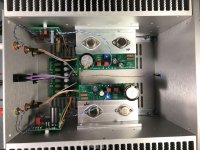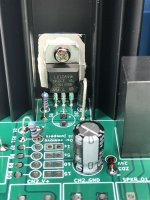The LD1084 is out of stock again until December. Has anyone confirmed if the LM1084 (or more expensive LT1084) are acceptable substitutes?
I have 4 off Tuba PCBs...only 1oz copper as I don't intend to run anywhere near 5A.
Will list in the swap meet and here at £3 each plus shipping
Please contact if you want one.
Will list in the swap meet and here at £3 each plus shipping
Please contact if you want one.
Trying another TUBA build. I could find everything at Mouser, except the big turret blocks. I found those at Allied.
Can share a Mouser BOM? ThxTrying another TUBA build. I could find everything at Mouser, except the big turret blocks. I found those at Allied.
I just used the one from the first post. I only had to swap a few things that were out of stock, but nothing hard to switch.
Any suggestions for C1? All the available 1uF, DC Link, polypropylene, caps have 27.5 mm pin spacing. I figured that out as I tried to install the one I had. the cap will still fit in length wise.
Bend the pins on the one I have, and figure out some way to secure the cap (double side adhesive foam tape is my current thought) Assuming we should use this spec above all else.
Or value change. Is there a “good range” that I can investigate? DC Link a requirevent? Or just any cap with ultra low ESR, film, 1uF, 100v…
Bend the pins on the one I have, and figure out some way to secure the cap (double side adhesive foam tape is my current thought) Assuming we should use this spec above all else.
Or value change. Is there a “good range” that I can investigate? DC Link a requirevent? Or just any cap with ultra low ESR, film, 1uF, 100v…
The specific Epcos DC Link cap whose part number appears in post #1 of this thread, is in stock today at both DigiKey and Mouser according to this link .
What's important for C1 is: (Capacitance * dV/dt). The Tuba schematic tells you to seek out a 1uF cap with dV/dt greater than 1E+8 (i.e. 100 volts per microsecond). When we calculate (Capacitance * dV/dt) we get (1E-6 * 1E+8) = 100. So you need to find a film capacitor whose body is 27 x 12mm or smaller, whose lead spacing is 22.5mm or less, and whose (Capacitance * dV/dt) is 100 or greater.
That won't be a simplistic job because dV/dt appears on the capacitor datasheets, but not in Mouser's or DigiKey's parametric search tables. So you'll have to identify a dozen candidates that are in stock, then carefully parse those dozen datasheets to dig out their dV/dt specification. DigiKey might be the best place to start; look in their parametric table for 1uF Film Capacitors and select all of the ones that say "DC Link" and/or "DV/DT" in the column called Applications. Those will be among the highest dV/dt film capacitors in their inventory.
I wouldn't stray too far from C1 = 1.0 microfarads though. You want C1 to mesh well with the other components of the filter (L1 - C2 - R1), and their values have been rather carefully chosen to be optimum when C1 is 1 microfarad.
As always: if you know what you're doing, make whatever changes you like. If you don't know what you're doing, don't make changes, use the parts the designer calls for.
What's important for C1 is: (Capacitance * dV/dt). The Tuba schematic tells you to seek out a 1uF cap with dV/dt greater than 1E+8 (i.e. 100 volts per microsecond). When we calculate (Capacitance * dV/dt) we get (1E-6 * 1E+8) = 100. So you need to find a film capacitor whose body is 27 x 12mm or smaller, whose lead spacing is 22.5mm or less, and whose (Capacitance * dV/dt) is 100 or greater.
That won't be a simplistic job because dV/dt appears on the capacitor datasheets, but not in Mouser's or DigiKey's parametric search tables. So you'll have to identify a dozen candidates that are in stock, then carefully parse those dozen datasheets to dig out their dV/dt specification. DigiKey might be the best place to start; look in their parametric table for 1uF Film Capacitors and select all of the ones that say "DC Link" and/or "DV/DT" in the column called Applications. Those will be among the highest dV/dt film capacitors in their inventory.
I wouldn't stray too far from C1 = 1.0 microfarads though. You want C1 to mesh well with the other components of the filter (L1 - C2 - R1), and their values have been rather carefully chosen to be optimum when C1 is 1 microfarad.
As always: if you know what you're doing, make whatever changes you like. If you don't know what you're doing, don't make changes, use the parts the designer calls for.
Last edited:
I see my mistake. I was searching for ”DC Link”, not “AC and Pulse” type. Not that I have clue to the differences of DC Link vs AC and Pulse capacitors.
Ive gotten too used to assign difficulty finding parts now, that I start with searches of the parts as listed in the BOM, and schematics. I searched for 1 uF DC Link film capacitors, and kept coming up with ones that are too big.
Ive gotten too used to assign difficulty finding parts now, that I start with searches of the parts as listed in the BOM, and schematics. I searched for 1 uF DC Link film capacitors, and kept coming up with ones that are too big.
Just a quick reminder that any and every diyAudio member can order Tuba PCBs directly from a PCB fab, and have them shipped straight to your house in your country. It's fun, it's easy, it's inexpensive. And it's also the next step up in maturity as a diyAudio builder.
The manufacturing CAD files ("Gerbers") are freely available for download. They are attached to post #1 in this thread.
Wield your bravery. Try something new, enjoy the thrill of success, learn, and grow.
The manufacturing CAD files ("Gerbers") are freely available for download. They are attached to post #1 in this thread.
Wield your bravery. Try something new, enjoy the thrill of success, learn, and grow.
Looks good, I'm happy you chose Color=Green and CopperWeight=2oz . Green is lightning fast through the PCB fab, and 2 oz copper will happily conduct high currents all day long without overheating.
Hi Mark, I have mounted zd1 and zd2 on the pcb oriented so that they are not too close to c5 c6, but now their body are touching the ld1084. Do you think it could be problematic?
Hubert
I did the same thing and the body of the diode was going to be on contact with the heatsink. I didn't like that option, so I removed it and placed it the other way round. It was lucky I bought extra diodes as you can not switch it once you cut the leads. Do I think it's a deal breaker? No I do not, but it's not optimal in my book. I would issue a caution here as most of the holes have extra room, these do not. It would be easy to hose the copper inside the whole by removing it without serious consideration and proper tools.
I would say yes, but if mounted vert, and flush, no, you may not bend the flush end without the possibility of ripping traces. Just saying... 🙂
I finished mine, I need to clean it up and test it. If anyone is interested, I will post pics, if not then I won't bother.
JT
JT
- Home
- Amplifiers
- Pass Labs
- Tuba SMPS filter: two linear regulators inside VFET/Theseus chassis; incl thump kill


